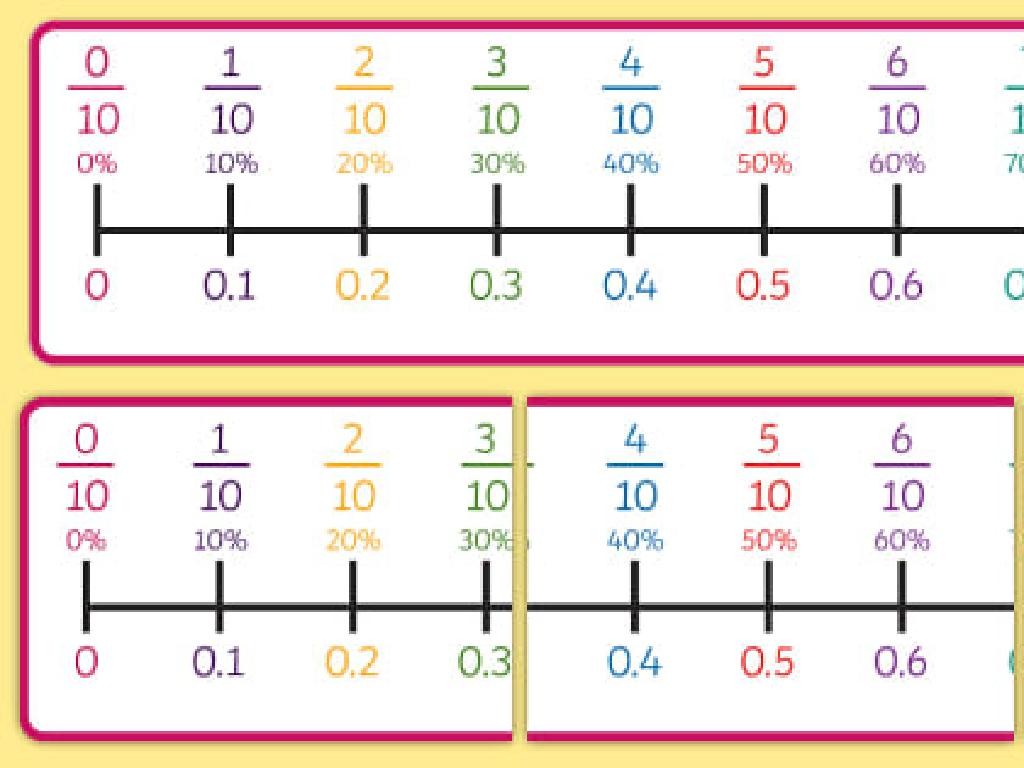Evaluate Rational Expressions
Subject: Math
Grade: Eighth grade
Topic: Expressions
Please LOG IN to download the presentation. Access is available to registered users only.
View More Content
Evaluating Rational Expressions
– Importance of expressions in math
Expressions are the building blocks of algebra.
– Review of expressions
Recall addition, subtraction, multiplication, division of terms.
– Evaluating rational expressions
Substitute values into expressions and simplify.
– Practice problems
|
This slide introduces the concept of evaluating rational expressions, which is a crucial skill in algebra. Start by discussing the significance of expressions in mathematics, emphasizing that they are used to represent real-world situations algebraically. Review previous lessons on expressions, including the basic operations involved in manipulating them. Then, explain how to evaluate rational expressions by substituting numbers for variables and simplifying the result. Provide practice problems for students to apply these concepts, ensuring a variety of examples to cover different cases they might encounter. Encourage students to ask questions and work through problems together to reinforce their understanding.
Evaluating Rational Expressions
– Importance of expressions in math
Expressions are the building blocks of algebra.
– Review of expressions
Recall addition, subtraction, multiplication, division of terms.
– Evaluating rational expressions
Substitute values into expressions and simplify.
– Practice problems
|
This slide introduces the concept of evaluating rational expressions, which is a crucial skill in algebra. Start by discussing the significance of expressions in mathematics, emphasizing that they are used to represent real-world situations algebraically. Review previous lessons on expressions, including the basic operations involved in manipulating them. Then, explain how to evaluate rational expressions by substituting numbers for variables and simplifying the result. Provide practice problems for students to apply these concepts, ensuring a variety of examples to cover different cases they might encounter. Encourage students to ask questions and work through problems together to reinforce their understanding.
Simplifying Rational Expressions
– Purpose of simplifying expressions
– To solve problems more easily and reduce complexity
– Factoring numerators and denominators
– Break down the top and bottom numbers into their prime factors
– Canceling common factors
– Remove the same numbers from top and bottom to simplify
– Simplified expressions in solutions
|
Simplifying rational expressions is a fundamental skill in algebra that helps students solve equations more efficiently and makes it easier to understand and work with expressions. Start by explaining the reasons for simplifying expressions, such as reducing complexity and preparing for further operations like addition or subtraction of fractions. Teach students how to factor both numerators and denominators by finding the prime factors or using techniques like grouping or the difference of squares. Emphasize the importance of canceling out common factors between the numerator and denominator to simplify the expression. Provide examples and practice problems to help students apply these concepts and recognize simplified expressions in their solutions.
Evaluating Rational Expressions
– Substitute values into expressions
– Replace variables with numbers to evaluate
– Understand the expression’s domain
– Domain: set of all possible values that can be used
– Work through a sample expression
– Example: Evaluate (x+3)/(x-2) for x=5
– Discuss why domain matters
– Domain excludes values that make the denominator zero
|
This slide introduces the process of evaluating rational expressions, which is a key concept in algebra. Start by explaining how to substitute values into the expression, emphasizing the importance of following the order of operations. Next, discuss the domain of the expression, which is crucial because certain values can make the expression undefined, such as when the denominator is zero. Work through an example together, such as evaluating (x+3)/(x-2) for x=5, to demonstrate the process. Finally, highlight why understanding the domain is important in evaluating expressions, as it ensures the expressions are meaningful and valid. Encourage students to ask questions and try additional examples for practice.
Evaluating Rational Expressions: Practice
– Work through example problems
– Example 1 with x=3
– Evaluate the given expression when x is substituted by 3
– Example 2 with x=-2, y=4
– Find the expression’s value for x=-2 and y=4
– Discuss solutions and methods
– Review steps taken and clarify any doubts
|
This slide is designed to engage students in active practice of evaluating rational expressions. Start with Example 1 by substituting x with 3 in the given expression and simplifying the result. For Example 2, demonstrate how to substitute both x and y values into the expression and simplify. Encourage students to follow along and solve on their own, then discuss the solution process. Emphasize the importance of substitution and simplification in evaluating expressions. Provide guidance on common pitfalls and ensure students understand each step before moving on. This interactive approach helps solidify their understanding of evaluating rational expressions.
Real-World Applications of Rational Expressions
– Rational expressions in daily life
– Used in cooking recipes, budgeting, and construction.
– Usage by engineers and scientists
– Essential in designing structures and conducting experiments.
– Example: Calculating rates
– Rates like speed: distance/time, or flow: volume/time.
– Example: Measuring efficiencies
– Efficiencies such as fuel usage: miles/gallon, or energy output/input.
|
This slide aims to show students the practical applications of rational expressions in various fields. Rational expressions are fractions that involve polynomials and are used in everyday life for tasks like adjusting recipes or creating budgets. Engineers and scientists frequently use these expressions to solve complex problems, design efficient systems, and conduct precise experiments. For example, calculating rates such as speed or flow involves rational expressions, as does determining efficiencies like fuel usage or energy conservation. Encourage students to think of other areas where they might encounter rational expressions and to understand the value of learning them.
Class Activity: Evaluate It!
– Form small groups
– Receive unique expressions
– Each group gets different rational expressions
– Evaluate your expressions
– Simplify the expressions, find the values
– Present findings to class
|
This activity is designed to promote collaborative learning and practice evaluating rational expressions. Divide the class into small groups, ensuring a mix of abilities in each. Provide each group with a set of rational expressions that are unique to them. These expressions should be at an appropriate difficulty level for eighth graders. Encourage students to work together to simplify the expressions and find their values. After the activity, each group will present their rational expressions and the steps they took to evaluate them. This will help reinforce their understanding and allow them to learn from each other. Possible expressions to use could include: (x+2)/(x-3), 3/(x+1), (2x-5)/(x^2-9), etc. Make sure to have a few extra expressions on hand in case a group finishes early.
Wrapping Up: Rational Expressions
– Review of today’s lesson
– Summarize key points: simplifying, finding values
– Open floor for questions
– Homework assignment
– Solve five rational expressions for practice
– Next steps
– Encourage reviewing notes before attempting homework
|
As we conclude today’s lesson on evaluating rational expressions, it’s important to recap the main concepts we’ve covered, including simplifying expressions and finding the values for variables that make the expressions true. Allow time for any lingering questions students may have; this ensures they leave the classroom with a clear understanding. For homework, students are tasked with evaluating five additional rational expressions, which will help reinforce their learning. Encourage them to review their notes and today’s examples before starting their homework. In the next class, we’ll discuss their solutions and address any difficulties they encountered.






